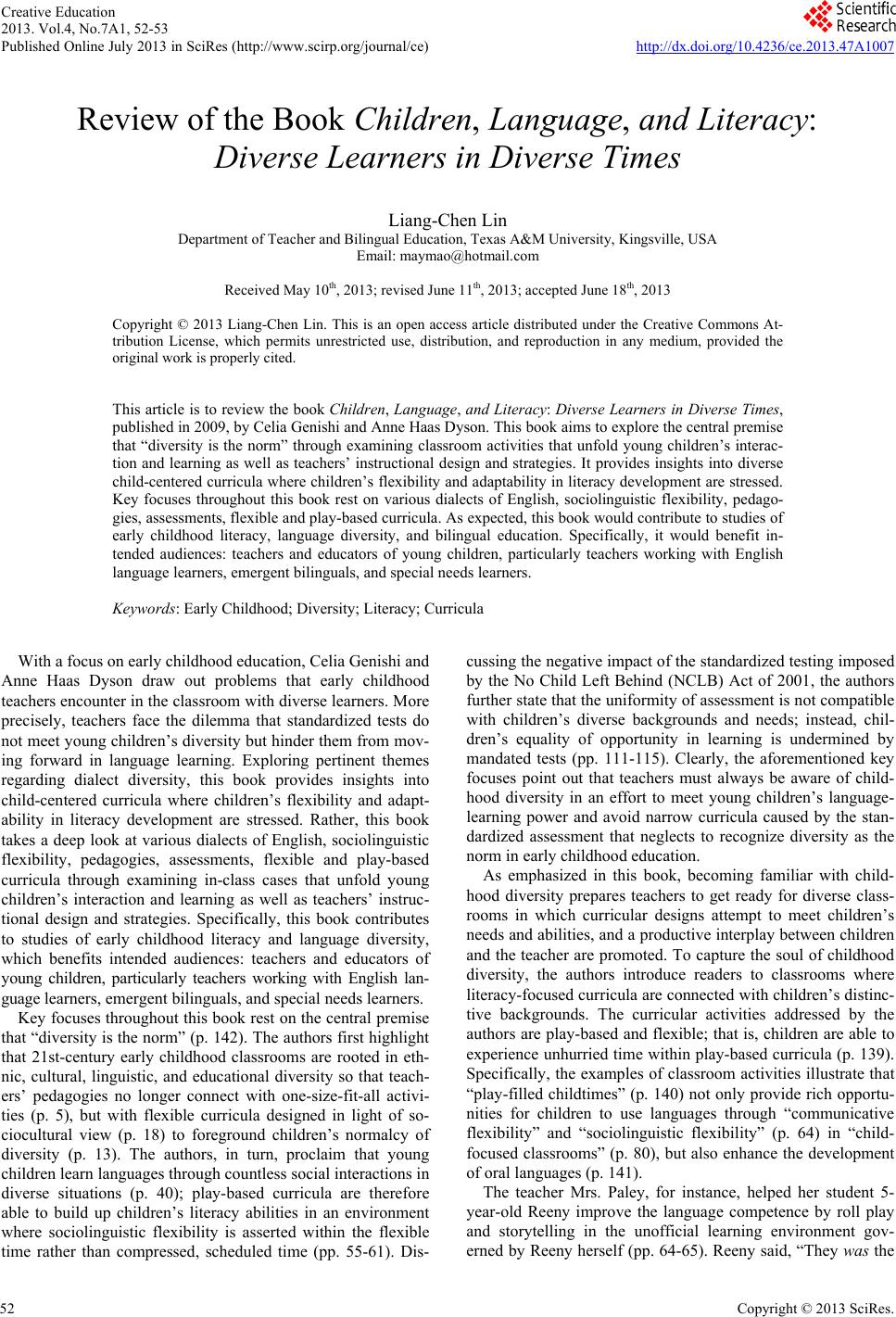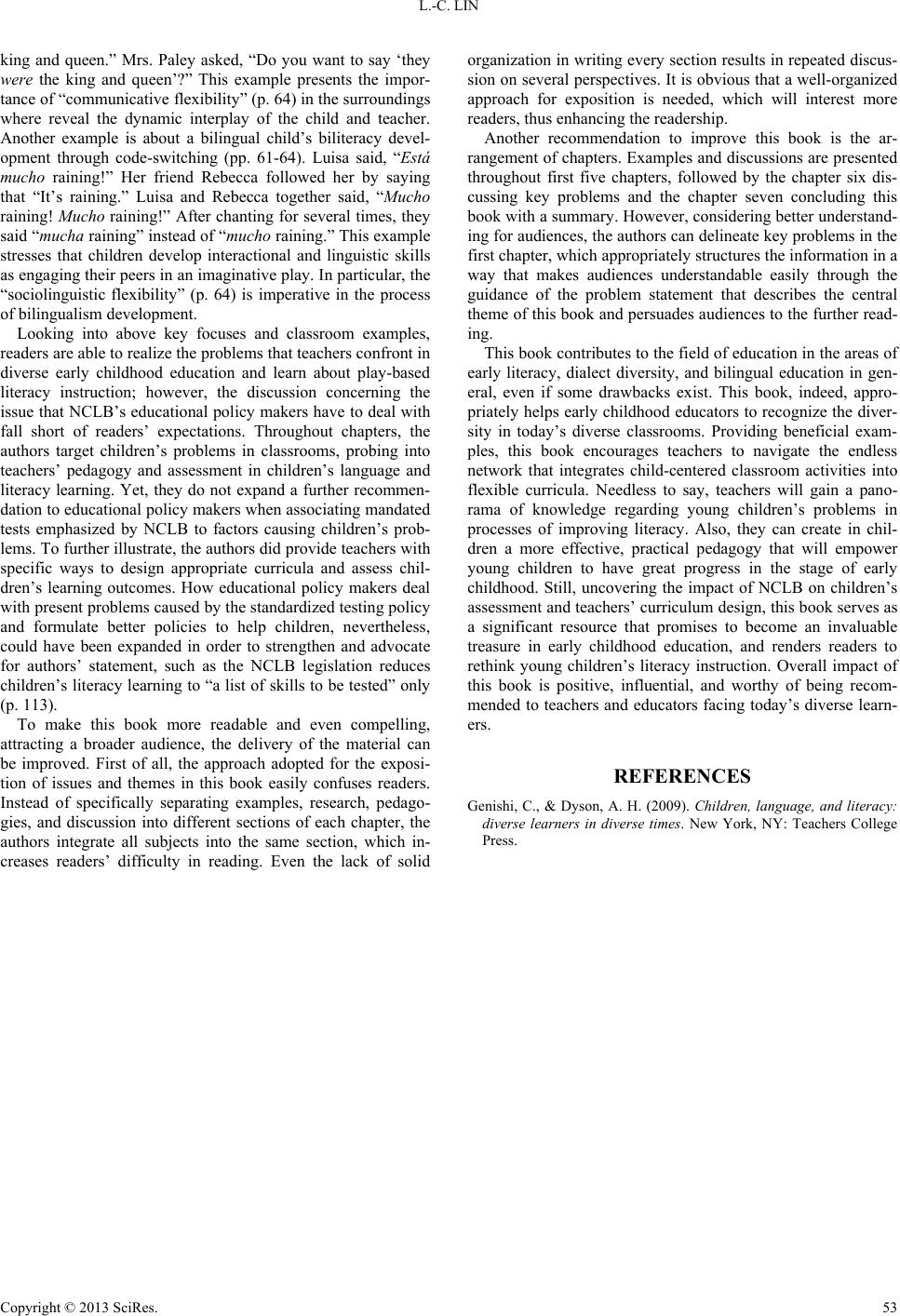Paper Menu >>
Journal Menu >>
 Creative Education 2013. Vol.4, No.7A1, 52-53 Published Online July 2013 in SciRes (http://www.scirp.org/journal/ce) http://dx.doi.org/10.4236/ce.2013.47A1007 Copyright © 2013 SciRes. 52 Review of the Book Children, Language, and Literacy: Diverse Learners in Diverse Times Liang-Chen Lin Department of Teacher and Bilingual Education, Texa s A&M University, Kingsville, USA Email: maymao@hotmail.com Received May 10th, 2013; revised June 11th, 2013; accepted June 18th, 2013 Copyright © 2013 Liang-Chen Lin. This is an open access article distributed under the Creative Commons At- tribution License, which permits unrestricted use, distribution, and reproduction in any medium, provided the original work is properly cited. This article is to review the book Children, Language, and Literacy: Diverse Learners in Diverse Times, published in 2009, by Celia Genishi and Anne Haas Dyson. This book aims to explore the central premise that “diversity is the norm” through examining classroom activities that unfold young children’s interac- tion and learning as well as teachers’ instructional design and strategies. It provides insights into diverse child-centered curricula where children’s flexibility and adaptability in literacy development are stressed. Key focuses throughout this book rest on various dialects of English, sociolinguistic flexibility, pedago- gies, assessments, flexible and play-based curricula. As expected, this book would contribute to studies of early childhood literacy, language diversity, and bilingual education. Specifically, it would benefit in- tended audiences: teachers and educators of young children, particularly teachers working with English language learners, emergent bilinguals, and special needs learners. Keywords: Early Childhood; Diversity; Literacy; Curricula With a focus on early childhood education, Celia Genishi and Anne Haas Dyson draw out problems that early childhood teachers encounter in the classroom with diverse learners. More precisely, teachers face the dilemma that standardized tests do not meet young children’s diversity but hinder them from mov- ing forward in language learning. Exploring pertinent themes regarding dialect diversity, this book provides insights into child-centered curricula where children’s flexibility and adapt- ability in literacy development are stressed. Rather, this book takes a deep look at various dialects of English, sociolinguistic flexibility, pedagogies, assessments, flexible and play-based curricula through examining in-class cases that unfold young children’s interaction and learning as well as teachers’ instruc- tional design and strategies. Specifically, this book contributes to studies of early childhood literacy and language diversity, which benefits intended audiences: teachers and educators of young children, particularly teachers working with English lan- guage learners, emergent bilinguals, and special needs learners. Key focuses throughout this book rest on the central premise that “diversity is the norm” (p. 142). The authors first highlight that 21st-century early childhood classrooms are rooted in eth- nic, cultural, linguistic, and educational diversity so that teach- ers’ pedagogies no longer connect with one-size-fit-all activi- ties (p. 5), but with flexible curricula designed in light of so- ciocultural view (p. 18) to foreground children’s normalcy of diversity (p. 13). The authors, in turn, proclaim that young children learn languages through countless social interactions in diverse situations (p. 40); play-based curricula are therefore able to build up children’s literacy abilities in an environment where sociolinguistic flexibility is asserted within the flexible time rather than compressed, scheduled time (pp. 55-61). Dis- cussing the negative impact of the standardized testing imposed by the No Child Left Behind (NCLB) Act of 2001, the authors further state that the uniformity of assessment is not compatible with children’s diverse backgrounds and needs; instead, chil- dren’s equality of opportunity in learning is undermined by mandated tests (pp. 111-115). Clearly, the aforementioned key focuses point out that teachers must always be aware of child- hood diversity in an effort to meet young children’s language- learning power and avoid narrow curricula caused by the stan- dardized assessment that neglects to recognize diversity as the norm in early childhood education. As emphasized in this book, becoming familiar with child- hood diversity prepares teachers to get ready for diverse class- rooms in which curricular designs attempt to meet children’s needs and abilities, and a productive interplay between children and the teacher are promoted. To capture the soul of childhood diversity, the authors introduce readers to classrooms where literacy-focused curricula are connected with children’s distinc- tive backgrounds. The curricular activities addressed by the authors are play-based and flexible; that is, children are able to experience unhurried time within play-based curricula (p. 139). Specifically, the examples of classroom activities illustrate that “play-filled childtimes” (p. 140) not only provide rich opportu- nities for children to use languages through “communicative flexibility” and “sociolinguistic flexibility” (p. 64) in “child- focused classrooms” (p. 80), but also enhance the development of oral languages (p. 141). The teacher Mrs. Paley, for instance, helped her student 5- year-old Reeny improve the language competence by roll play and storytelling in the unofficial learning environment gov- erned by Reeny herself (pp. 64-65). Reeny said, “They was the  L.-C. LIN king and queen.” Mrs. Paley asked, “Do you want to say ‘they were the king and queen’?” This example presents the impor- tance of “communicative flexibility” (p. 64) in the surroundings where reveal the dynamic interplay of the child and teacher. Another example is about a bilingual child’s biliteracy devel- opment through code-switching (pp. 61-64). Luisa said, “Está mucho raining!” Her friend Rebecca followed her by saying that “It’s raining.” Luisa and Rebecca together said, “Mucho raining! Mucho raining!” After chanting for several times, they said “mucha raining” instead of “mucho raining.” This example stresses that children develop interactional and linguistic skills as engaging their peers in an imaginative play. In particular, the “sociolinguistic flexibility” (p. 64) is imperative in the process of bilingualism development. Looking into above key focuses and classroom examples, readers are able to realize the problems that teachers confront in diverse early childhood education and learn about play-based literacy instruction; however, the discussion concerning the issue that NCLB’s educational policy makers have to deal with fall short of readers’ expectations. Throughout chapters, the authors target children’s problems in classrooms, probing into teachers’ pedagogy and assessment in children’s language and literacy learning. Yet, they do not expand a further recommen- dation to educational policy makers when associating mandated tests emphasized by NCLB to factors causing children’s prob- lems. To further illustrate, the authors did provide teachers with specific ways to design appropriate curricula and assess chil- dren’s learning outcomes. How educational policy makers deal with present problems caused by the standardized testing policy and formulate better policies to help children, nevertheless, could have been expanded in order to strengthen and advocate for authors’ statement, such as the NCLB legislation reduces children’s literacy learning to “a list of skills to be tested” only (p. 113). To make this book more readable and even compelling, attracting a broader audience, the delivery of the material can be improved. First of all, the approach adopted for the exposi- tion of issues and themes in this book easily confuses readers. Instead of specifically separating examples, research, pedago- gies, and discussion into different sections of each chapter, the authors integrate all subjects into the same section, which in- creases readers’ difficulty in reading. Even the lack of solid organization in writing every section results in repeated discus- sion on several perspectives. It is obvious that a well-organized approach for exposition is needed, which will interest more readers, thus enhancing the readership. Another recommendation to improve this book is the ar- rangement of chapters. Examples and discussions are presented throughout first five chapters, followed by the chapter six dis- cussing key problems and the chapter seven concluding this book with a summary. However, considering better understand- ing for audiences, the authors can delineate key problems in the first chapter, which appropriately structures the information in a way that makes audiences understandable easily through the guidance of the problem statement that describes the central theme of this book and persuades audiences to the further read- ing. This book contributes to the field of education in the areas of early literacy, dialect diversity, and bilingual education in gen- eral, even if some drawbacks exist. This book, indeed, appro- priately helps early childhood educators to recognize the diver- sity in today’s diverse classrooms. Providing beneficial exam- ples, this book encourages teachers to navigate the endless network that integrates child-centered classroom activities into flexible curricula. Needless to say, teachers will gain a pano- rama of knowledge regarding young children’s problems in processes of improving literacy. Also, they can create in chil- dren a more effective, practical pedagogy that will empower young children to have great progress in the stage of early childhood. Still, uncovering the impact of NCLB on children’s assessment and teachers’ curriculum design, this book serves as a significant resource that promises to become an invaluable treasure in early childhood education, and renders readers to rethink young children’s literacy instruction. Overall impact of this book is positive, influential, and worthy of being recom- mended to teachers and educators facing today’s diverse learn- ers. REFERENCES Genishi, C., & Dyson, A. H. (2009). Children, language, and literacy: diverse learners in diverse times. New York, NY: Teachers College Press. Copyright © 2013 SciRes. 53 |

